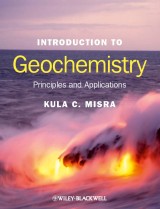Details

Introduction to Geochemistry
Principles and Applications1. Aufl.
|
50,99 € |
|
| Verlag: | Wiley-Blackwell |
| Format: | EPUB |
| Veröffentl.: | 28.03.2012 |
| ISBN/EAN: | 9781444347197 |
| Sprache: | englisch |
| Anzahl Seiten: | 464 |
DRM-geschütztes eBook, Sie benötigen z.B. Adobe Digital Editions und eine Adobe ID zum Lesen.
Beschreibungen
<b>INTRODUCTION TO Geochemistry</b> <p>This book is intended to serve as a text for an introductory course in geochemistry for undergraduate/ graduate students with at least an elementary-level background in earth sciences, chemistry, and mathematics. The text, containing 83 tables and 181 figures, covers a wide variety of topics – ranging from atomic structure to chemical and isotopic equilibria to modern biogeochemical cycles – which are divided into four interrelated parts: Crystal Chemistry; Chemical Reactions (and biochemical reactions involving bacteria); Isotope Geochemistry (radiogenic and stable isotopes); and The Earth Supersystem, which includes discussions pertinent to the evolution of the solid Earth, the atmosphere, and the hydrosphere. <p>In keeping with the modern trend in the field of geochemistry, the book emphasizes computational techniques by developing appropriate mathematical relations, solving a variety of problems to illustrate application of the mathematical relations, and leaving a set of questions at the end of each chapter to be solved by students. However, so as not to interrupt the flow of the text, involved chemical concepts and mathematical derivations are separated in the form of boxes. Supplementary materials are packaged into ten appendixes that include a standard-state (298.15 K, 1 bar) thermodynamic data table and a listing of answers to selected chapter-end questions.
<p>Preface xiii</p> <p>1 Introduction 1</p> <p><b>Part I Crystal Chemistry 7</b></p> <p>2 Atomic Structure 9</p> <p>3 Chemical Bonding 23</p> <p><b>Part II Chemical Reactions 49</b></p> <p>4 Basic Thermodynamic Concepts 51</p> <p>5 Thermodynamics of Solutions 79</p> <p>6 Geothermometry and Geobarometry 107</p> <p>7 Reactions Involving Aqueous Solutions 134</p> <p>8 Oxidation–Reduction Reactions 167</p> <p>9 Kinetics of Chemical Reactions 197</p> <p><b>Part III Isotope Geochemistry 223</b></p> <p>10 Radiogenic Isotopes 225</p> <p>11 Stable Isotopes 253</p> <p><b>Part IV The Earth Supersystem 281</b></p> <p>12 The Core–Mantle–Crust System 283</p> <p>13 The Crust–Hydrosphere–Atmosphere System 326</p> <p>Appendix 1 Units of measurement and physical constants 372</p> <p>Appendix 2 Electronic configurations of elements in ground state 374</p> <p>Appendix 3 First ionization potential, electron affinity, electronegativity (Pauling scale), and coordination numbers of selected elements 377</p> <p>Appendix 4 Thermodynamic symbols 379</p> <p>Appendix 5 Standard state (298.15 K, 10<sup>5</sup> Pa) thermodynamic data for selected elements, ionic species, and compounds 382</p> <p>Appendix 6 Fugacities of H<sub>2</sub>O and CO<sub>2</sub> in the range 0.5–10.0 kbar and 200–1000°C 396</p> <p>Appendix 7 Equations for activity coefficients in multicomponent regular solid solutions 398</p> <p>Appendix 8 Some commonly used computer codes for modeling of geochemical processes in aqueous solutions 400</p> <p>Appendix 9 Solar system abundances of the elements in units of number of atoms per 10<sup>6</sup> silicon atoms 402</p> <p>Appendix 10 Answers to selected chapter–end questions 403</p> <p>References 406</p> <p>Index 431 </p>
<p>“This is a good book to study if you want to build your understanding of geochemistry on a solid quantitative footing.” (<i>Open University Geological Society Journal</i>, 1 May 2013)</p> “Overall, this seems to be a useful book for its intended audience . . . I would recommend the book to those outside of geochemistry to expand their knowledge of the topic before entering the subject matter at a higher level.” (<i>Chromatographia</i>, 28 March 2013) <p>“Summing Up: Recommended. Graduate students and above.” (<i>Choice</i>, 1 January 2013)</p> <p>“Overall this is an impressively thorough and up-to-date text that is aimed at the ‘geological’ geochemist and I would certainly recommend it to such an audience.” (<i>Geological Magazine</i>, 2012)</p> <p> </p>
<p><b>KULA C. MISRA</b> is a Professor of Geology (Emeritus) at the University of Tennessee where he has taught geochemistry, economic geology, and environmental geology for more than 30 years. He received a M.Tech degree in Applied Geology from the Indian Institute of Technology (Kharagpur) and, after working for about ten years as a field geologist, a Ph.D. degree in Geology from the University of Western Ontario (Canada). His research papers have been published in several professional journals, and he is the author of the textbook <i>Understanding Mineral Deposits</i> published in the year 2000. He is a member of several professional organizations and has served as a consultant to corporations and government agencies on subjects related to mineral deposits and environmental geochemistry.
<p>This book is intended to serve as a text for an introductory course in geochemistry for undergraduate/ graduate students with at least an elementary-level background in earth sciences, chemistry, and mathematics. The text, containing 83 tables and 181 figures, covers a wide variety of topics – ranging from atomic structure to chemical and isotopic equilibria to modern biogeochemical cycles – which are divided into four interrelated parts: Crystal Chemistry; Chemical Reactions (and biochemical reactions involving bacteria); Isotope Geochemistry (radiogenic and stable isotopes); and The Earth Supersystem, which includes discussions pertinent to the evolution of the solid Earth, the atmosphere, and the hydrosphere. <p>In keeping with the modern trend in the field of geochemistry, the book emphasizes computational techniques by developing appropriate mathematical relations, solving a variety of problems to illustrate application of the mathematical relations, and leaving a set of questions at the end of each chapter to be solved by students. However, so as not to interrupt the flow of the text, involved chemical concepts and mathematical derivations are separated in the form of boxes. Supplementary materials are packaged into ten appendixes that include a standard-state (298.15 K, 1 bar) thermodynamic data table and a listing of answers to selected chapter-end questions.
Diese Produkte könnten Sie auch interessieren:

Contaminated Soils, Sediments and Water:

von: Edward J. Calabrese, Paul T. Kostecki, James Dragun

149,79 €















